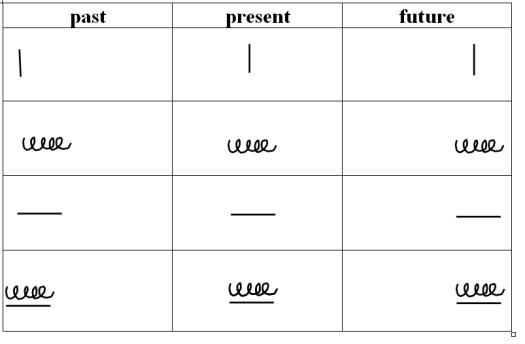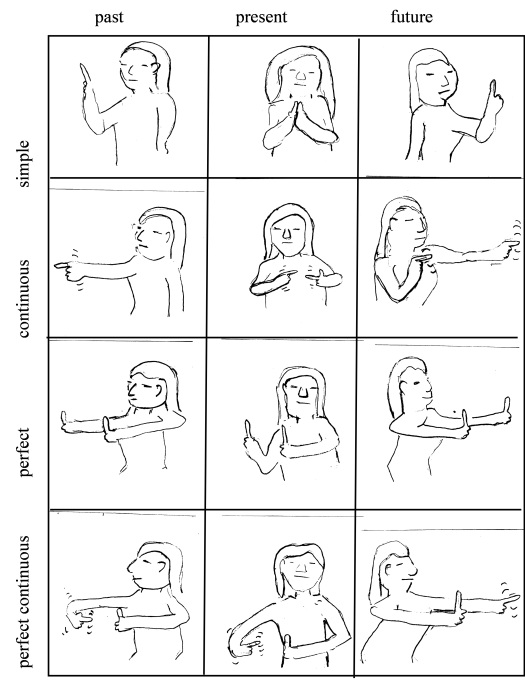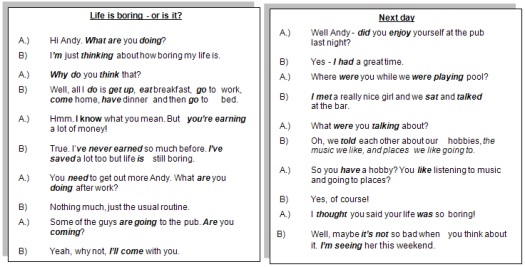For more activities from Pilgrims read Creating Calm in the Classroom”: Pilgrims Training Session by Dave Read and Alphabet Games: a Pilgrims Training Session by Hania Kryszewska
Tense Experience: A Pilgrims Training Session by Emmanuelle Betham
Peter Clements, UK
Peter Clements teaches ESOL in the Adult Lifelong Learning sector in and around Canterbury, Kent in the UK. He works with a variety of students from inside the European Union as well as long- term UK residents from numerous other countries including members of the large Nepalese community who live in south east England. He started out teaching ESOL in 2007. E-mail: peter.clements@talktalk.net
Contrary to any tension that may have been suggested by the title of this workshop, the teachers attending who are naturally ‘in the know’ about such matters, anticipated something to do with verb forms. Indeed, Emmanuelle introduced this workshop as a way of helping teachers deal effectively with the frequent requests for ‘grammar’ while still being able to use a largely lexical approach.
To get us in the right frame of mind, we were invited to rapidly come up one by one to complete the following table outlined on the board:
| past |
present |
future |
| she sang |
she sings |
she will sing |
| |
|
|
| |
|
|
| |
|
|
So far, so good, it was very familiar to English teachers. Soon, our chart had been completed like this:
| past |
present |
future |
| she sang |
she sings |
she will sing |
| she was singing |
she is singing |
she will be singing |
| she had sung |
she has sung |
she will have sung |
| she had been singing |
she has been singing |
she will have been singing |
Two things are of note here. The underlining of the ‘-ing’ to emphasize form and the absence of any labels indicating aspect. The reason for this is in order to emphasis the start, duration and completion of actions.
Emmanuelle then introduced a simple way of denoting these actions (avoiding use of the word ‘aspects’)’
The following symbols were used.

So changing the table by having the participants come up to the board and using the symbols as substitutes, we could now see a much more visual version that focused on the nature of the actions rather than the usual table of names:

This system of symbols made for a nice visual way of representing and comparing starting and finishing points as well as sustained action or movement in either of three general time frames. This shows a clear pattern and relationship of structure without students needing to get bogged down with confusing terminology at this stage.
This was now translated to a series of useable hand signals which could be used in various ways in the classroom. First of all, here are past, present and future simple with a gesture indicating the vertical line denoting a single or regular action. The hand is held still. In representing the present simple, the palms can be pressed together centrally to the body.
Now note below how Emmanuelle elicited the other forms and thus took us visually through the rest of the symbols previously written on the board (at fig 3).

The illustrations above are not intended to be used or be issued in printed form but as an active, animated way of representing the main verb structures. At any point in a lesson, students can be reminded of the type of action or state a verb represents and the gestures are easy to master. The pattern can clearly be seen, just as in the symbols used in fig 3 show a distinct pattern.
Emmanuelle demonstrated the kinesthetic element in use through a ‘call and response’ type of reinforcement where learners use the gestures to demonstrate their awareness of the verb forms while reading a dialogue. As the dialogue was read, individuals from our group were required to run to a chair, which represented the present point in time, and then position ourselves in relation to the chair to form a human timeline. This was a really fun and lively way of bringing grammar to life!
How I used it in a lesson
As a stimulus, earlier in the lesson, working in pairs, we had taken the roles of two people having a conversation in a kind of mini play. The play Emmanuelle had written included all the verb forms that were to appear in the chart. As we analyzed the narrative, we took turns to approach the board, writing the symbols representing the actions on a timeline. Ways of representing simultaneous actions were explored, earlier continuous events starting in the past being interrupted by single events as well as subsequent actions likely to happen /have happened in the future. The benefit of using a suitable scale so that these actions could be placed chronologically was also discussed. (For a useful example of portraying overlapping actions in all tenses see http://eolf.univ-fcomte.fr).
To illustrate how I applied part of this session in a later lesson, here is a text I prepared for a class of ESOL E2 (elementary) students preparing to explain their daily routine and then give a brief account of a recent past event. These students, all of whom live and work in the UK in a distribution warehouse, often complain that they don’t do anything interesting, hence the topic!).

After a reading the dialogue in pairs, the students were then asked analyze the text and write a letter above every verb highlighted in bold indicating whether they thought it was past, present or future.( I did not include verb sub- phrases and avoided participle adjectives such as ‘boring’ to avoid confusion).
Next, in two groups, the students had to place the verb forms on a timeline relative to each other and write the appropriate symbol alongside it. Generally, the activity was successful and I found myself using the gestures quite freely as a way of correcting and reminding them. Things aren’t always as clear cut however and the present continuous used for the future such as ‘Are you coming?’ and ‘I’m seeing her this weekend,’ gave opportunities for speculation and discussion rather than their being simply told that ‘the present continuous is used to describe future actions’. In my view, it kind of answers such so called anomalies as perceived by the student, in a logical, visual way that avoids lengthy explanations.
A lot easier than using the usual names for the tenses and aspects which can be so confusing for students, this technique seems to suggest, as Emmanuelle put it, that students can soon acquire a ‘feel’ for what is actually happening as suggested by verbs rather than the textbook approach of designations we tend to quote from most descriptive grammars. This was a valuable experience for the students who are able to get by in their speaking skills but require a greater degree of grammatical accuracy for their speaking exams.
The next logical step, would be to have the students write their own narratives or mini-plays, and see how well they are able to use the particular verb aspect in their writing and assess their accuracy. With the students on my short course mentioned above, the students went on to plan and their own monologues - I think in hindsight, writing dialogues in pairs would have been more beneficial for them.
Conclusions
This was a most interesting session which provided a useful toolkit that went beyond the simple hand gestures I usually use for indicating past and future and a vague way of representing durative aspects. I could find nothing comparable on the internet that incorporates the physical element in this way.
The closest I could find was in Michel Lewis’ The English verb and some of the written timelines which are more familiar to English teachers.
The gesture and single symbol used for the present simple however does not adequately reflect the frequency of repeated action or general truths. However, in practice this is often represented in a series of vertical strokes, or in the case of the physical gestures, this could be a series of hand chops. Many teachers use a series of dots around the present point.
There are elements of this system I will continue to use in future classes. I can really see the benefits that will come from introducing this element of a TPR approach with learners.

Please check the Creative Methodology for the Classroom course at Pilgrims website.


|